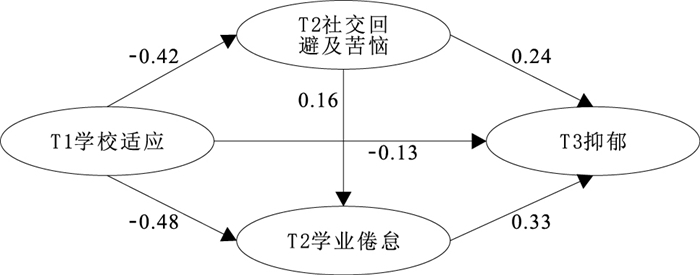Longitudinal relationship between social avoidance and distress, learning burnout, school adaptation and depression among high school students
-
摘要:
目的 探讨学校适应对高中生抑郁的影响,以及社交回避及苦恼和学业倦怠在两者关系中的中介作用,为高中生心理健康工作提供依据。 方法 采用方便抽样法选取贵阳市2所中学1 207名高一学生为研究对象,使用学校适应量表(SAS)、社交回避及苦恼量表(SAD)、学业倦怠量表(LBQ)和患者健康问卷(PHQ-9),在2021年10月(T1)、2022年5月(T2)、2023年3月(T3)3个时间点进行调查。采用Harman单因素法进行共同方法偏差检验;通过Bootstrap法进行偏差校正,使用重复抽样5 000次的方式分析参数估计的95%置信区间(95%CI)。 结果 T1学校适应负向预测T3高中生的抑郁(β=-0.13,P<0.01);中介检验表明,T2的社交回避及苦恼在时间点T1的学校适应与时间点T3的高中生抑郁间的中介效应值为-0.100(95%CI=-0.134~-0.071);第2次测量(T2)的学业倦怠在时间点T1的学校适应与时间点T3的高中生抑郁间的中介效应值为-0.157(95%CI=-0.211~-0.106);第2次测量(T2)的社交回避及苦恼和学业倦怠在时间点T1的学校适应与时间点T3的高中生抑郁间的链式中介效应值为-0.022(95%CI=-0.037~-0.012)(P值均<0.05)。 结论 良好的学校适应可直接缓解高中生抑郁,也可通过社交回避及苦恼和学业倦怠间接减少高中生抑郁。家庭和学校应重视高中生入学适应情况,并对适应不良学生及时提供干预和帮助,减少高中生抑郁情绪的发生。 Abstract:Objective To examine the influence of school adaptation on depression among high school students, as well as the mediating effects of social avoidance and distress and learning burnout on the relationship between school adaptation and depression among high school students, so as to provide a basis for the mental health promotion among high school students. Methods A convenience sampling method was used to select 1 207 first-year high school students from two high schools as the research subjects in Guiyang City. The School Adaptation Scale(SAS), Social Avoidance and Distress Scale(SAD), Learning Burnout Questionnaire(LBQ), Patient Health Questionnaire-9(PHQ-9) were used to conduct surveys at three time points: October 2021 (T1), May 2022 (T2), and March 2023 (T3). Common method biase was tested using the Harman's single-factor method, and bias correction was conducted via the Bootstrap method, utilizing 5 000 resamples to analyze the 95% confidence intervals(95%CI) of parameter estimates. Results School adaptation at T1 was negatively associated with depression of high school students at T3 (β=-0.13, P<0.01). The mediation analysis showed that the mediating effect of social avoidance and distress at T2 between school adaptation at time point T1 and depression among high school students at time point T3 was-0.100 (95%CI=-0.134-0.071, P<0.05). The mediating effect of learning burnout at T2 between school adaptation at time point T1 and depression among high school students at time point T3 was-0.157 (95%CI=-0.211-0.106, P<0.05). The chain mediation effect of social avoidance and distress and learning burnout at T2 between school adaptation at time point T1 and depression among high school students at time point T3 was -0.022 (95%CI=-0.037-0.012, P<0.05). Conclusions Good school adaptation can directly alleviate depressive mood, and can indirectly reduce depression through social avoidance and distress and learning burnout among high school students. Families and schools should pay attention to the school adaptation of high school students and provide timely interventions and assistance to students with poor adaptation. -
Key words:
- Social avoidance and distress /
- Learning /
- Fatigue /
- Adaptation, psychological /
- Depression /
- Students
1) 利益冲突声明 所有作者声明无利益冲突。 -
表 1 不同组别高中生学校适应、社交回避及苦恼、学业倦怠及抑郁量表得分比较[M(P25,P75)]
Table 1. Comparisons of the scores on the school adaptation, social avoidance and distress, and learning burnout and depression scales among high school students of parent-divorce different groups[M(P25, P75)]
组别 选项 人数 统计值 学校适应
(T1)社交回避及苦恼(T2) 学业倦怠
(T2)抑郁
(T3)性别 男 593 117(106, 127) 8(5, 14) 43(36, 51) 2(0, 5) 女 614 117(106, 127) 9(5, 13) 44(36, 53) 2(0, 5) Z值 -0.52 0.41 0.69 0.85 P值 0.60 0.68 0.49 0.40 心理健康状况 良好 1 092 118(107, 127) 8(5, 13) 43(36, 51) 2(0, 5) 一般或差 115 106(92, 121) 13(7, 17) 50(34, 61) 11(9, 14) Z值 -5.13 4.38 3.03 12.28 P值 < 0.01 < 0.01 < 0.01 < 0.01 合计 1 207 117(106, 127) 8(5, 14) 44(36, 52) 2(0, 5) 表 2 高中生社交回避及苦恼和学业倦怠的中介效应检验(n=1 207)
Table 2. Test of the mediating effects of social avoidance and distress and learning burnout among high school students(n=1 207)
路径 标准化效应值(95%CI) 效果量/% 总效应 -0.406(-0.460~-0.349) T1学校适应→T3抑郁 -0.127(-0.203~-0.049) 31.28 总间接效应 -0.279(-0.335~-0.229) 68.72 T1学校适应→T2社交回避及苦恼→T3抑郁 -0.100(-0.134~-0.071) 24.63 T1学校适应→T2学业倦怠→T3抑郁 -0.157(-0.211~-0.106) 38.67 T1学校适应→T2社交回避及苦恼→T2学业倦怠→T3抑郁 -0.022(-0.037~-0.012) 5.42 -
[1] 崔娜. 初中生学校适应与自我概念的相关研究[D]. 重庆: 西南大学, 2008.CUI N. A study on the relationship of school adaptation and self-conception among junior school students[D]. Chongqing: Southwest University, 2020. (in Chinese) [2] 程少贵, 高鹏, 李济平, 等. 高职学生学校生活适应不良在自闭特质与抑郁关系中的中介作用[J]. 中华疾病控制杂志, 2023, 27(10): 1204-1211. https://www.cnki.com.cn/Article/CJFDTOTAL-JBKZ202310014.htmCHENG S G, GAO P, LI J P, et al. The mediating effect of school life maladjustment on the relationship between autistic traits and depression in vocational college students[J]. Chin J Dis Control Prev, 2023, 27(10): 1204-1211. (in Chinese) https://www.cnki.com.cn/Article/CJFDTOTAL-JBKZ202310014.htm [3] 赵若兰, 楼淑萍, 陈辉. 适应不良与大学生持续性自我伤害行为的关系及抑郁的中介效应[J]. 华中科技大学学报(医学版), 2019, 48(3): 334-338. https://www.cnki.com.cn/Article/CJFDTOTAL-TJYX201903016.htmZHAO R L, LOU S P, CHEN H. Mediating effect of depression on the association between persistent non-suicidal self-injury and college adjustment among college students[J]. Acta Med Univ Sci Technol Huazhong, 2019, 48(3): 334-338. (in Chinese) https://www.cnki.com.cn/Article/CJFDTOTAL-TJYX201903016.htm [4] WATSON D, FRIEND R. Measurement of social-evaluative anxiety [J]. J Consult Clin Psychol, 1969, 33(4): 448-457. doi: 10.1037/h0027806 [5] PELEG O. Social anxiety and social adaptation among adolescents at three age levels[J]. Soc Psychol Educ, 2012, 15(2): 207-218. doi: 10.1007/s11218-011-9164-0 [6] YUAN Y, JIANG S, WEN X, et al. The chain-mediation pathway of social avoidance to depression in college students is regulated by self-esteem[J]. Front Psychol, 2022, 13: 802161. doi: 10.3389/fpsyg.2022.802161 [7] 李莉红, 陈明, 程亚华, 等. 相对剥夺感与大学生抑郁的关系: 领悟社会支持、社交回避及苦恼的链式中介作用[J]. 中国健康心理学杂志, 2020, 28(11): 1700-1704. https://www.cnki.com.cn/Article/CJFDTOTAL-JKXL202011021.htmLI L H, CHEN M, CHENG Y H, et al. Relationship between relative deprivation and depression in college students: the chain mediating effect of perceived social support and social avoidance and distress[J]. Chin J Health Psychol, 2020, 28(11): 1700-1704. (in Chinese) https://www.cnki.com.cn/Article/CJFDTOTAL-JKXL202011021.htm [8] 胡俏, 戴春林. 中学生学习倦怠结构研究[J]. 心理科学, 2007, 30(1): 162-164. https://www.cnki.com.cn/Article/CJFDTOTAL-XLKX200701040.htmHU Q, DAI C L. A research on middle school students' learning burnout structure[J]. Psychol Sci, 2007, 30(1): 162-164. (in Chinese) https://www.cnki.com.cn/Article/CJFDTOTAL-XLKX200701040.htm [9] FENGJUN Q, JING Z, LIGUANG L, et al. The effect of mental toughness on learning burnout of junior middle school students: putting school adaptation as a mediator variable[J]. Discrete Dyn Nat Soc, 2022, 2022: 1-9. [10] SCHLECHTER P, HELLMANN J H, MORINA N. Self-discrepancy, depression, anxiety, and psychological well-being: the role of affective style and self-efficacy[J]. Cognit Ther Res, 2022, 46(6): 1075-1086. doi: 10.1007/s10608-022-10314-z [11] SHARIFIFARD F, ASAYESH H, HOSSEINI M H M, et al. Motivation, self-efficacy, stress, and academic performance correlation with academic burnout among nursing students[J]. J Nurs Midwifery Sci, 2020, 7(2): 88. doi: 10.4103/JNMS.JNMS_30_19 [12] CHENG J, ZHAO Y Y, WANG J, et al. Academic burnout and depression of Chinese medical students in the pre-clinical years: the buffering hypothesis of resilience and social support[J]. Psychol Health Med, 2020, 25(9): 1094-1105. doi: 10.1080/13548506.2019.1709651 [13] JIANG Y, LIN L, HU R. Parental phubbing and academic burnout in adolescents: the role of social anxiety and self-control[J]. Front Psychol, 2023, 14: 1157209. doi: 10.3389/fpsyg.2023.1157209 [14] KROENKE K, SPITZER R L, WILLIAMS J B W. The PHQ-9: validity of a brief depression severity measure[J]. J Gen Intern Med, 2001, 16(9): 606-613. doi: 10.1046/j.1525-1497.2001.016009606.x [15] 荣泰生. AMOS与研究方法[M]. 重庆: 重庆大学出版社, 2010: 165.RONG T S. AMOS and research methods[M]. Chongqing: Chongqing University Press, 2010: 165. (in Chinese) [16] CHANG C, YUAN R, CHEN J. Social support and depression among Chinese adolescents: the mediating roles of self-esteem and self-efficacy[J]. Child Youth Serv Rev, 2018, 88: 128-134. doi: 10.1016/j.childyouth.2018.03.001 [17] TOMÁS J M, GUTIÉRREZ M, PASTOR A M, et al. Perceived social support, school adaptation and adolescents' subjective well-being[J]. Child Indic Res, 2020, 13(5): 1597-1617. doi: 10.1007/s12187-020-09717-9 [18] GOTLIB I H, HAMMEN C L. Handbook of depression[M]. New York: Guilford Press, 2008: 322-340. [19] FOLKMAN S, LAZARUS R S. Coping as a mediator of emotion[J]. J Pers Soc Psychol, 1988, 54(3): 466-475. doi: 10.1037/0022-3514.54.3.466 [20] XIE X, WANG X, WANG P, et al. Academic adaptation and pursuit of the symbolic function of mobile phones among adolescents: moderating role of self-identity and mediating role of academic performance[J]. Child Indic Res, 2019, 12(3): 861-872. doi: 10.1007/s12187-018-9560-5 [21] CHRISTY X I, MYTHILI T. Self-esteem, self-efficacy and academic performance among adolescents[J]. J Indian Assoc Child Adolesc, 2020, 16(2): 123-135. -







 下载:
下载:

